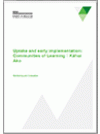This report provides an overview of the early implementation of Communities of Learning | Kāhui Ako (Communities of Learning) up to December 2016
Key Results
Momentum is increasing for the establishment of Communities of Learning. Approvals and achievement challenge endorsements have accelerated during 2016. Almost two-thirds (62%) of schools eligible to access the three new roles were in Communities of Learning by the end of December 2016. At this stage, about one-fifth of schools are in Communities of Learning with endorsed achievement challenges and are in the early stages of implementation.
Strong foundations for collective impact and productive collaboration are in place: High levels of shared purpose and commitment, confidence about working with other members, and understanding why working together is important. Communities of Learning are confident about their capability to use data to identify achievement challenges, and to monitor and evaluate how well the actions they are taking are working. For sustainable collective impact, the active engagement of all stakeholders will be critical if Communities of Learning are to transform the education landscape and its outcomes. At this stage, Boards are participating and engaging at lower levels than other members of Communities of Learning and parent/family/whānau involvement is not yet well developed.
Communities of Learning recognise that student achievement is a key measure of success. However tracking and measuring change in leadership and teaching practice features less significantly in plans about what to monitor. This suggests that Communities of Learning will need support to monitor the line of sight between what they are acting on – leadership and teaching – and how this translates into tangible improvement in learners’ rates of progression and their achievement results.
Communities of Learning are making a strong start in their implementation journey. The picture we see so far points to the complexity of creating a system-wide change in a highly differentiated implementation environment. Implementation success depends on a constellation of local factors that make it easier for some and more difficult for others. The Ministry will need to be able to identify these communities and provide appropriate and tailored support when needed.
Schools that do and do not belong to Communities of Learning are similar. There do not appear to be obvious differences in the characteristics of schools that do and schools that do not belong to Communities of Learning. However, there is likely to be a complex relationship between more "objective" characteristics – numbers of members and students, scale and depth of achievement challenges, and decile composition – and less apparent attributes and qualities. For the Ministry and its sector partners supporting Communities of Learning, understanding how these features interact will be critical to ensure services and supports are responsive and targeted to what Communities of Learning need to be successful.
Communities of Learning share a focus on common achievement challenge topics – reading, writing, mathematics, NCEA Level 2 – but the targets that they set vary considerably in their scale, level of granularity, focus on priority learners, and ambition. Although people in the new roles are working on the same sorts of challenges, variations in the breadth, scale and scope of these challenges will mean each Community of Learning will use these roles quite differently.
Backfilling staff is challenging for some Communities of Learning. The degree to which this will be an issue for Communities of Learning mostly depends on the availability of the local teacher workforce.
Communities of Learning are implementing a broadly framed but not prescriptive model, working in highly localised implementation contexts. It will take time to understand the factors that shape their success and how best to support this. We know that implementation support will need to be nuanced and bespoke, and lined up to the individual characteristics of Communities of Learning in their early development. Over time, the model will evolve as early adopters share their learning, and greater clarity emerges about what elements of the model are critical for success and need to be implemented consistently alongside those that can be more flexible and locally responsive.

